| Di Zi Chang Di Qu Di |
The Dizi, (pronounced Dee Zzzt – like a bumble bee sound), is the traditional Chinese flute. It is believed to have been brought in from Tibet during the Han Dynasty and since then it has been used for over the past 2,000 years in China. Dizi are made from bamboo and have six finger holes and are characterized by an additional hole covered by a piece of very thin paper-like fiber membrane that buzzes slightly when played. | 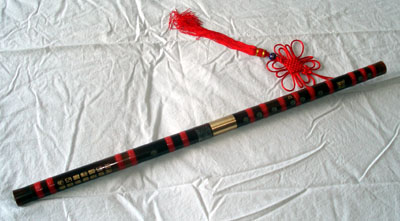 |
|
The modern Dizi has a range of about two and a half octaves. It is often bound with bands of silk or thread to guard against cracking. The di mo membrane is either made from the inner layer of a certain type of bamboo or from a type of river reed. The di mo is held in place by placing a small amount of natural gum or garlic juice around the hole, and slightly moistening as it is placed into position. The di mo must dry to the proper tension to produce the dizi's characteristic loud sound.
The player plays the Dizi by blowing across the mouthpiece and produces different notes by stopping the six holes found in the rod. The player uses several distinct playing techniques: fluttered tonguing, double tonguing, triple tonguing, combinations of tonguing techniques and fingering techniques. A skilled player will also use circular breathing. Traditionally players have a set of dizi, one for each desired key. Accidentals and slides were accomplished by very subtle adjustments of the fingers to cover only a quarter or half of a hole. Although a relatively easy instrument at first, the standard for good dizi playing is extremely high, and professional dizi players from China are stunning in their virtuosity. |
The Bangdi (a short dizi with membrane) is popular in the north, predominantly as an accompanying instrument to the regional Clapper Opera or as part of folk ensembles in the north. It is a little shorter and smaller than the Qudi, with a higher register and brighter tone. It is performed with an animated and leaping rhythm. The technique is in tonguing.
The Qudi (a long dizi with membrane) is popular in the south, predominantly as an accompanying instrument to Kun Opera or as part of folk ensembles. In performance it characterizes itself with a rounded, rich tone. It is sweet and fluid, with a rhythm that progresses steadily, while the melody tends to move in undulating patterns. The technique is in breathing control. The Dadi and Xindi fill out the low range of the Dizi section. The Xindi has no membrane and its tone colors are more on the muted side. The Dadi has a membrane and its tone is deep and rich. The Dizi was also known as hengchui or hengdi in the ancient times. Early in the reign of Emperor Wudi (141-88 BC) of the Han dynasty, the Dizi was introduced to China from the ethnic minorities of northwest China. In the reign of Emperor Han Wu, it was an important instrument in guchui (drum and wind music). Later, it became common all over the country, and many versions evolved. But generally they fell under either the Qudi or the Bangdi category. Since the Ming and Qing Dynasties (1644-1911), it has been used as an accompanying instrument in theatrical music. | |
| Xiao |
The Xiao (Pronounced Sheeow) is a wind instrument that is made out of bamboo. It is played by blowing into one end. It has a low sound different from the Di Zi. | 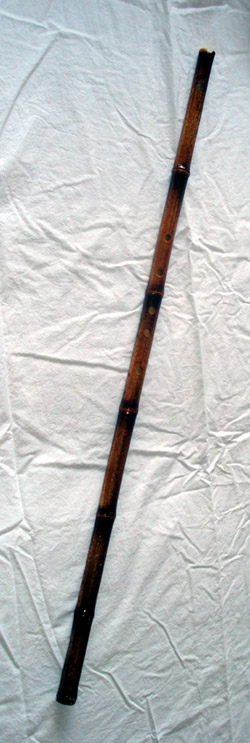 |
| Suona |
The Suona (pronounced Swoh Na) is a reed instrument that is very bright in color and sound. It is usually featured in the celebratory music for weddings. | 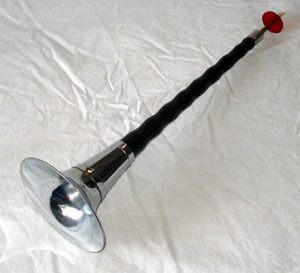 |
| Er Hu |
The erhu, (pronounced Are Who?), is the most common two-string stick fiddle of China. The name translates roughly to the words "two" and "barbarian", as it came to China approximately a thousand years ago from the tribal peoples of the north. The erhu has a sweet round tone and is capable of a high degree of virtuosity. With a range of about three octaves, its sound is rather like a violin, but with a thinner tone due to the smaller resonating chamber covered with python skin. The erhu is a very popular instrument and can be found in almost all forms of music in China. | 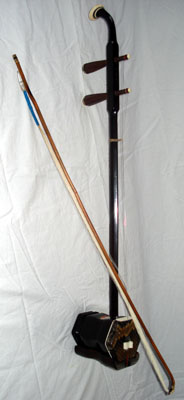 |
|
The erhu sounds similar to the human voice, and can imitate many natural sounds such as birds and horse. It is a very expressive instrument, most well-known for playing melancholic tune, but also capable of playing a happy melody. It assumes a central position in the modern Chinese orchestra, similar to the violin in the Western orchestra, as well as in the accompaniment of singing and dancing.
There are two strings, with the bow inserted between them. The two tuning handles (pegs) are found close to the end of the stem. There are no frets (as on the lute or guitar) or finger board (as on the violin). The player creates different pitches by touching the strings at various positions along the neck of the instrument. The bow is manufactured of reed or bamboo which one curves during cooking, and strung with horsehair like the bow of a violin. The player of an erhu usually plays sitting down, and the erhu is placed on the left upper thigh in front of the hip. The instrument is played by moving the bow horizontally across one of the two vertical strings. Playing techniques are rich, including, harmonic tones, trills, glissandos, pizzicatos for the left hand and legatos, detaches, martellatos, saltandos, tremolos, flying staccatos for the right hand. The erhu's range spans about three octaves. It has some of the qualities of a violin, but with more of a nasal tone. The erhu is capable of producing a gentle yet firm tone. | The erhu evolved from the yazheng, which was a bowed zither of the Tang Dynasty (618-907), and the xiqin originating from a Mongolian tribe Xi found around the areas of Xilamulun River in northeast China. In the early period, it was played with a bamboo stick pressing on the strings and therefore the tone color tended to be brilliant with a metallic quality. By the Song Dynasty (960-1279), the bamboo stick was replaced by a bow. It was among the instruments played at the imperial banquets. During the Dynasties of Ming (1368-1644) and Qing (1644-1911), the erhu underwent a great development at the time of the golden age of the local operas. Two famous artists Hua Yanjun (1893-1950) and Liu Tianhua (1895-1932) both made large contributions to the improvement of the erhu, and it was indeed due to the latter that the erhu, an instrument mainly for accompaniment in an opera, becomes a solo instrument. Today, the erhu has become a leading or solo instrument. | |
| Zhong Hu |
The Zhong Hu (pronounced Joh-ng Who?), is an Alto version of the Er Hu. Its body is slightly larger and the strings are tuned to an A below middle C and an E a fifth above that A. | 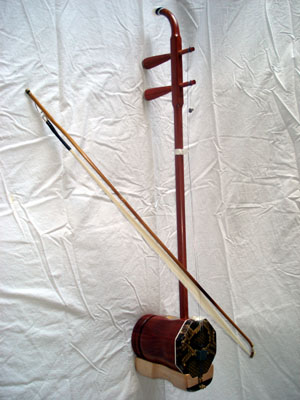 |
| Ban Hu |
The Ban Hu (pronounced Bahn Who?) is similar to the Er Hu in construction with the major difference being that instead of a python skin, it uses a thin piece of wood as the resonator. | 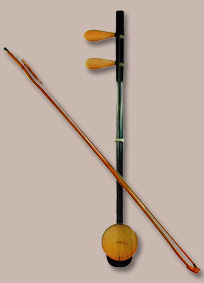 |
| Gao Hu |
The Gao Hu (pronounced Gow Who?) is slightly smaller than the Er Hu, and has a more nasal tone to its sound. It is similarly tuned to a D above middle C and an A a fifth above that. | 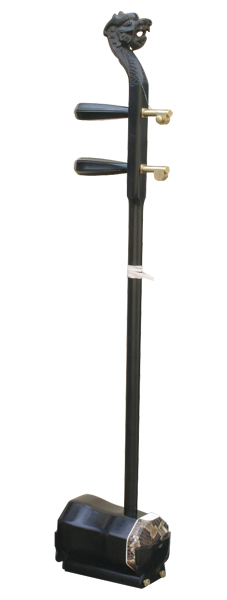 |
| Ge Hu |
The Ge Hu (pronounced Guh Who?) was invented in the 1950's as Chinese culture sought to add bass sounding instruments to the tones of Chinese instruments. | 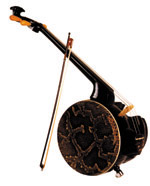 |
| Gu Zheng |
 |
|
| The zheng or guzheng (pronounced "Goo Jung"), is the parent instrument of the Asian long zither family. Originally believed to have been invented during the Qin Dynasty (897-221 BC), and new evidence has shown that the zheng may even be older (in Mandarin the prefix “gu” means “antiquity”). It existed already in the Warring States Period (403-221 B.C.), and was extremely popular in the State of Qin (around the Shaanxi region). Hence it was also referred to as Qin zheng. In the first century AD, the zheng is described as a plucked half-tube wood zither with movable bridges, over which a number of strings are stretched, and in the 2nd century BC the zheng was described as having twelve silken strings and high narrow jade bridges.
The instrument is rich in playing techniques. The performer uses the right hand to pluck the strings, with the left hand pressing the string on the left side of the bridge to produce vibrato, pitch alterations or slides. Sounding melodious and elegant, it is an important solo instrument now, and often in accompaniments as well. It has a loud and bright tone. The left hand often joins the right hand to play a counter-melody. If its strings are struck consecutively, it produces a sound like flowing water. It is capable of interpreting music of various moods, from the classically elegant to flying passions. Traditionally, it was used in ensembles and for accompanying folk narrative singing. The timbre of zheng varies from the pristine and elegant to the crisp and sprightly according to the different kind of strings (silk or metal) used. The zheng is traditionally tuned to a pentatonic scale, but many modern scales range from combinations of different pentatonic scales, to diatonic and semi-chromatic scales. The sound box is constructed of wood, red sandalwood for its sides and bottom and wutong wood for the arched soundboard. Each string is suspended over the upper soundboard by a single adjustable bridge as a device for fine tuning. The strings were traditionally silk, but now are steel wire with or without nylon coiling. The 21 strings are tuned to give three complete octaves of a pentatonic scale, sometimes of a heptatonic one. The pitch of a given string is determined by the position of the bridge, therefore the Guzheng can in principle be tuned to any desired scales. A full scale can also be obtained by skillfully pressing on certain strings from the other side of the bridge with the left hand. | ||
| Yang Qin |
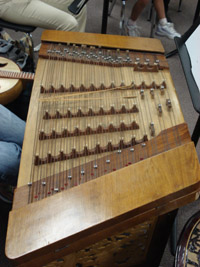 |
|
| The Yangqin, (pronounced Yang Cheen), is a Chinese hammered dulcimer with a near-squared soundboard. The instrument is played with two bamboo sticks. Besides daqin (struck instrument), one of its other names means "foreign instrument" in its original Chinese character, owing to the fact that the yangqin is an adaptation of the Persian Santur or some other Arabian type of hammered dulcimer. The yangqin is also called "hudie qin (butterfly lute)" and "shanmian qin (fan shaped lute). At first it was found in Persia (now Iran) and Arabia, then made its inroads into China towards the end of the Ming Dynasty (1368-1644).
The original was confined to the south-eastern coastal province of Guangdong late in the Ming dynasty (c. the 16th century). It spread later throughout the inner areas. The Yangqin comes in a variety of sizes. It is played with bamboo mallets, that are the size of a chopstick, with one held in each hand. They are used to hit strings in pairs. This produces a high and tinkling timbre in its top registers, a soft and beautiful tone in the middle and a strong rich sound in the lower registers. The metallic tone resembles the harpsichord. It has the widest range of scale amongst the Chinese plucked-strings instruments (about 5 octaves). Under the box is a damper to control lingering tones. The instrument, bright and harmonious in tone, is often used for solos and in ensembles or in the accompaniment of local operas, narratives and other vocal singings. The yangqin is important in instrumental ensembles for its crisp tone quality, wide tonal range as well as chord, quick arpeggio capability and timbre. It is therefore popularly used for ensemble music playing as well as accompaniment. | ||
| Pi Pa |
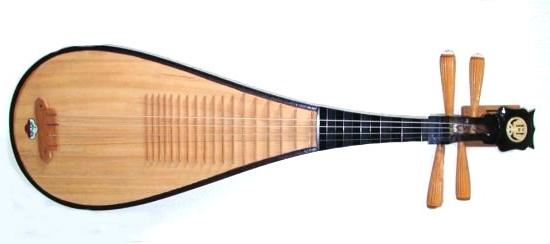 |
|
| The pipa (pronounced Pee Pah) is a four stringed lute with a pear-shaped body. This instrument is one of the oldest instruments in China, appearing in texts dating back to the second century B.C. Traditionally pipa is mainly a solo instrument, sometimes played in folk ensembles such as traditional silk and bamboo ensembles that are common found in South-East China, or used to accompany story telling, or local opera. Nowadays, the pipa is more often used in contemporary compositions for ensemble, orchestra, and various combinations with both Chinese and western instruments. The name, Pipa, comes from a combination of pi and pa, originally referring to two right-hand techniques: pi means "to play forward", and pa "to play backward". | ||
| Zhong Ruan |
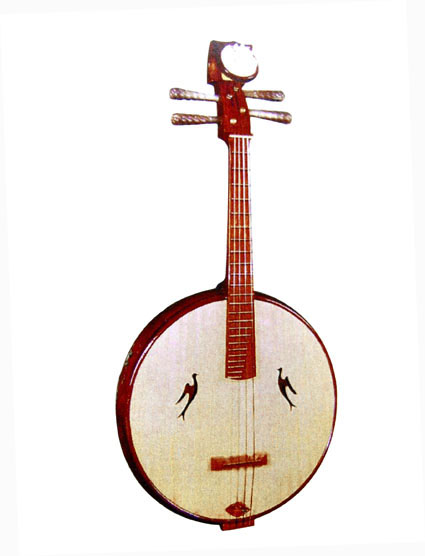 |
|
| The Ruan is a very ancient four-stringed moon-shaped lute with a long and straight neck and various number of frets. Ruan used to be called "p'i-p'a" (pipa) or qin-pipa. Mellow in tone quality, it is often seen in ensembles or in accompaniments, and also as a solo instrument.
It is a short necked Chinese foiled lute with four strings, played by plectrum. It is used by orchestras as well as for accompanying operatic performances. The Ruan consists of three parts: resonator, neck and head. On the neck are 24 frets in half steps. Four strings, tuned to fifths (like a mandolin), provide a wide range of notes. It comes in several sizes according to their different ranges constructed as a family of soprano, alto, tenor and bass. The alto (Xiao Ruan) and the tenor (Zhong Ruan) are commonly used. A plectrum or pick is needed in performance. Mellow in tone quality, it is often seen in ensembles or in accompaniments, and as a solo instrument in recent years. The Ruan has a beautiful mellow tone that is very similar to that of the guitar. The Ruan is mostly used for Peking opera, and now also in modern Chinese orchestra. Common tunings are GDAE or ADAD for the Ruan and BFCG, CGDA, or CGCG for the Da Ruan. The Ruan was once termed as Qin pipa (dating to the Qin dynasty between 221-207BC) or Yueqin (moon shaped short neck lute). Since the introduction of the oud-like lute through the "silk-road" in the early Tang Dynasty (around 5th century), the Pipa gradually developed into the present form, and the old form of Pipa with straight-neck and round body got the name "Ruan", after the name of the master player of this instrument. That player, Ruan Xian, was one of the seven great scholars known as "The Seven Gentlemen in the Bamboo Forest" in Chinese history of the 3rd century (the Six Dynasties). Among the artifacts unearthed in the Six Dynasties (220-581) Tomb at Xishan Bridge, Nanjing, there was an engraved picture showing Ruan Xian, playing a musical instrument. During the Sui and Tang dynasties (581-907), the Ruan was generally used for playing court music and folk dance music. There are many 7th Century depictions of the ruan in court orchestras painted on the walls of caves in DunHuang. In ancient times the Ruan had 8 frets; nowadays it is equipped with 4 strings and 24 frets. | ||
| Gu Qin |
 |
|
| The Gu qin, (prounounced Goo Cheen), is a seven-stringed zither without bridges. It is the oldest known Chinese instrument with over 3000 years of history. It is called qin, meaning “instrument”, but commonly known as "guqin" where "gu" means “ancient”.
The instrument’s range can reach four octaves or more. Its basic tuning is: C D F G A c d. Its music is elegant and full of lingering charms. Its tone qualities are variable: deep and vigorous in the low register, pure and mellow in the middle, bright and delicate in the high. In addition to these tones, it has a large number of rich, crystal clear harmonics. Due to its sophisticated playing technique and quiet sound, it is often played solo or in duets with the vertical dongxiao flute for private or intimate audiences. The Guqin is made up of a long, narrow upper wooden board made from the tong tree (or other trees of the pine family) and a lower board is made from the catalpa tree or some other hardwood. These two pieces of boards are glued together and lacquered. There are 13 small mother of pearl dots (called hui) inlaid on the outside of the upper board, which mark the positions of the musical notes and their harmonics. Seven strings are stretched on the upper board, starting from the thickest one on the outside to the thinnest on the inside. Compared with other Chinese instruments, the guqin is unique in at least three respects: The effective vibrating length of the strings is longer than any of the other Chinese instruments, resulting in a large vibrating amplitude and a tone rich in the lower register that fits the sound of nature. The fingerboard does not have any frets. Its sound holes are on the bottom, so the sound is transmitted downwards. Over 100 harmonics can be played, making the instrument one with the largest number of harmonic overtones. Learning to play qin was traditionally regarded as a very important element in education for the purpose of enriching the heart and elevating human spirit. In Imperial China, scholars and ladies of the high society were expected to master the four arts, namely, the qin (guqin), qi (weiqi or Go), shu (Calligraphy), and hua (painting). The guqin has historically been regarded as the symbol of Chinese high culture. Unfortunately, only a small number of people in China play the instrument because classical musical education for this instrument has never reached the general public. The repertoire for the guqin has been much better preserved than any other ancient instruments. The earliest recorded qin scores can be traced back to the Nan Dynasty (494 AD - 590 AD), and many of these ancient pieces are said to have been written in the Han Dynasty (206 BC - 220 AD) and possibly earlier. It is estimated that there are over three thousand qin pieces in existence, and many of these pieces are still played today on the qin. Ancient tablatures of its music number over a thousand, representing a vast repertoire from various schools. The qin was the instrument of the literati through the ages. Even Confucius (around 600 BC) was a master of this instrument. Legends and stories described in the historical sources surround the qin with an aura of romanticism. One is about Yu Boya, a qin player, whose performing was so deeply appreciated by his friend Zhong Ziqi for its spiritual nature that when Ziqi died, Boya destroyed his qin, as he believed there would be no one to appreciate his music properly. Another tale is told that Zhuge Liang, the prime minister of the Shu Kingdom (221-263), playing the qin on the gate tower; though without any garrisons inside, intimidated the enemy troops headed by General Sima Yi. Remains of the Guqin have been found in ancient tombs (500 to 200 BC). The form of the instrument today is almost the same as it was nearly 1,600 years ago. Today, guqins from the Tang Dynasty (618 - 907 AD) can be found in museums. In November 2003, the Guqin was been registered as one of the master pieces of the Oral and Intangible Heritage of Humanity by the United Nations' Educational, Cultural and Scientific Organization (UNESCO). |
| Mu Yu (Wood Fish) |
The Mu Yu (pronounced Moo You) is a hammered wood block instrument that is made into different sizes that are partially hollowed out giving it a knocking sound. | 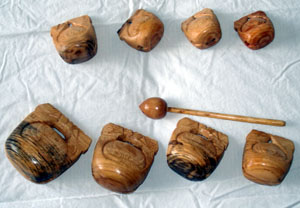 |
| Peng Ling (Bells) |
The Peng Ling are two smaller bells about an inch and a half in diameter that are connected by a string. They have a tone higher than the Triangle percussion instrument used in Western orchestras. | 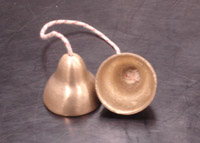 |
| Shuang Yin Tong |
The Shuang Yin Tong (pronounced Shwahng Een Toh-ng) is simply a two tone knocker percussion instrument, many times associated with the clip-clop of horse hooves. | 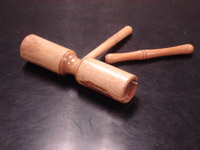 |
| Xiao Bo |
The Xiao Bo (pronounced Shee-ow Bwo) are small cymbal type percussion instruments about 6 inches in diameter. They are used in many types of music especially the local folk opera music. | 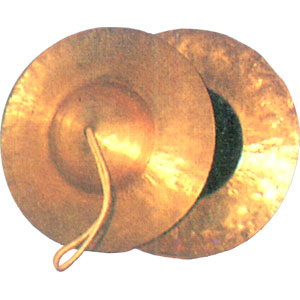 |
| Xiao Luo |
| |
| Ban Gu |
 | |
| Fang Xiang | 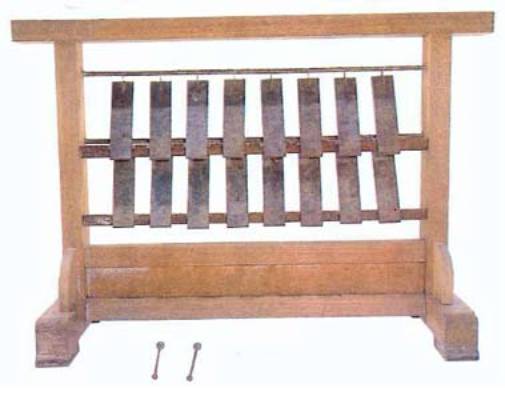 |